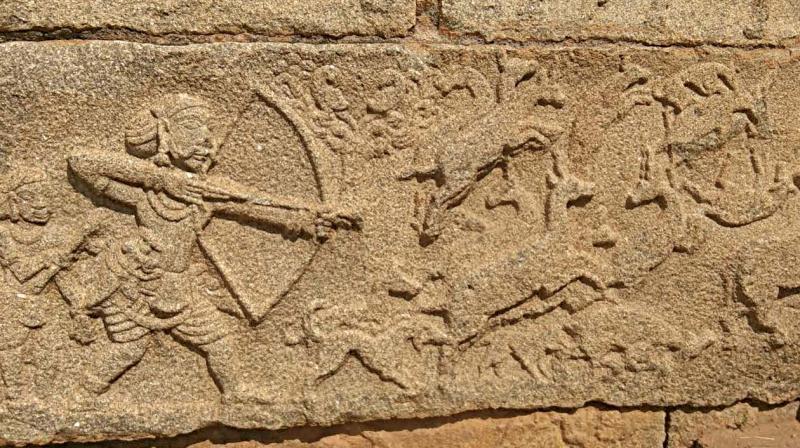Hampi and the Mudhol hounds

Ballari: In the first week of January, eight Mudhol Hounds, bred at the Canine Research and Information Centre in Timmapur, Bagalkot district will be inducted into the Indian Army, and wait for this ... goose step their way down Raj Path as part of the Republic Day parade in New Delhi.
Where did these supremely elegant, long-necked, long legged creatures come from? In recently found murals on the walls of the fiftteenth century Vijayanagara kingdom that stood fast against invaders drawn to its fabled riches are carvings that may give us a clue on the origins of the Mudhol Hounds.
The chronicles of foreign travellers and traders visiting Hampi, the erstwhile capital of the Vijayanagar empire, are revealed on its walls. Carvings along the walls of a stone platform built by king Deva Raya I show foreign traders, Arabs and Portuguese, French and Chinese dressed in traditional attire, with the Arabs parting with their prized Arab stallions for gold. There are scenes of a royal ceremony, pictures of city life featuring foreign envoys to the kingdom and hunting tableaux. Located within the ruins of the royal enclosure at the world heritage site of Hampi today, the platform called the Mahavanami Dibba, was used by kings and vassals to view the might of their military and the nine-day Dasara festivities.
The three layered structure was first built by Deva Raya I (1406-24) and later developed by his successors, Devaraya II (1424-46) and Sri Krishna Devaraya (1509-29).
One of the more interesting murals is of a bearded Arab, holding a couple of long legged, deep-chested dogs with large eyes, drooping ears, and a long and curved tail, that strongly resemble the famed Mudhol Hound. The dogs are shown accompanying the king and other royals on hunts and fighting with a tiger in a forest.
Widely believed to be descendants of breeds, such as the Greyhounds and the Saluki from the Middle East, that accompanied early traders, mercenaries, and invaders from Central and Western Asia to India, the Mudhol hounds may have been the product of foreign dogs cross-bred with local breeds to create India's first native hounds, and named for the region where they were bred. Hence, the name, the Mudhol Hound, for the small town of Mudhol in Bagalkot district.
Legend has it that Sri Srimanth Raja Malojirao Ghorpade, who once ruled Mudhol, gave King George V. of England a pair of these puppies and it was he who named them, the Mudhol Hounds.

